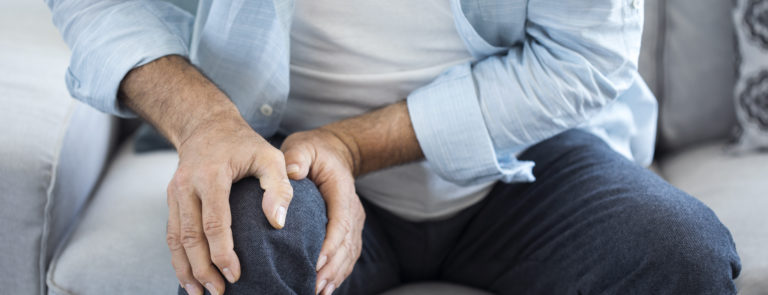15% off £40
Code:QUICK
8 joint pain relief remedies

If you are looking for home remedies for joint pain relief then you’ve come to the right place. Find out 8 science-based remedies which may help ease your pain.
Summary
1 Four reasons we get joint pain
There are many possible causes, although the NHS states that this is often down to arthritis or as a result of injury. Arthritis is a progressive...
2When to see your doctor/GP about joint pain
You should speak to your GP or doctor if your joint pain or continued joint pain lasts for longer than two weeks...
3The most effective supplements for joints
While it would be easy if we could suggest the best thing for joint pain for you, the truth is that everyone has different needs. Which is why you...
In this article we’ll talk you through joint pain relief and remedies for joint pain that you can do at home, for both long-term and short-term joint problems.
It is important that you do not use this information to self-diagnose any joint pain you may be experiencing, and if you have any concerns then please contact your GP.

Common types of joint pain
According to the NHS, there are seven different types of joint pain:1
- knee pain
- shoulder pain
- hip pain
- foot pain, including your ankle and toes
- hand pain, including your wrist and fingers
- elbow pain
- neck pain

Four reasons we get joint pain
But what causes joint soreness in these areas? There are many possible causes, although the NHS states that this is often down to arthritis or as a result of injury.1 Arthritis is a progressive condition that can steadily worsen and affect your joints longer term.
Joint pain that is caused by injury may not need the attention of a GP, but it can still be debilitating and will often need medical attention.
Here are some of the most common reasons we get joint pain...
Inflamed tissue lining of the joints and tendons is a condition called synovitis. This often occurs if you have recently injured a joint and it becomes painful again.
If you are experiencing pain that occurs in repeated attacks, it’s possible that it could be gout or pseudogout, which are both a type of arthritis.
Gout usually affects the joint of the big toe before other joints. Attacks usually begin with the skin getting hot and red.
Pseudogout is a similar condition to gout, but usually affects the knee joint first.2
If you think you have gout, it’s important that you get a correct diagnosis, so make sure you see your GP in the first instance.
If you are experiencing knee pain that feels worse when you go up or down stairs, this could be a sign of a condition called chondromalacia patellae, which in simple terms is a damaged kneecap.3
There’s no proven cause around this, although it’s generally linked to overuse of the knee.
If you have had a recent injury to the knee joint, such as a torn ligament or fractured knee, there is a chance that it may cause bleeding into the joint spaces, which is known as haemarthrosis.4
Symptoms of haemarthrosis are:
- swelling of the knee
- pain
- warmth
- bruising and stiffness
Less common causes for joint pain
Sudden joint pain is commonly caused by:5
- a fracture to the arm or wrist
- broken leg, ankle or hip
- reactive arthritis
- psoriatic arthritis
- rheumatoid arthritis
Eight joint pain relief remedies
So, what can you do to help? Discover our top eight joint pain relief remedies below...

1. Keep active
If your joint pain is causing you pain and stiffness, you may think that exercise will worsen symptoms.3
Yet, regardless of your age or level of fitness, exercise is one of the best ways to avoid and help soothe joint pain – especially if it’s related to osteoarthritis.6
You should try to include a combination of exercises that can strengthen your muscles and improve your general fitness.
However, before beginning an exercise programme you should seek advice from your GP or a medical professional who will be able to advise further on what you should or should not be doing, particularly if you are recovering from surgery.
2. Losing weight
Your hips, knees and ankles tend to take a lot of the strain when carrying your weight, so it stands to reason that being overweight can often make your joint pain worse, as it places extra strain on some of your joints.7
You can try to lose weight by attempting to do more physical activity and by eating a balanced diet.

3. Pain relief medication
If you experience regular joint pain, your GP may suggest painkillers as a way to manage your pain. Here’s what the NHS says about using painkillers for managing joint discomfort from osteoarthritis:6
Paracetamol
If you have joint pain, paracetamol can be purchased from supermarkets or pharmacies.
To manage your pain in the best way possible, you should always keep to the recommended dose and timings.
Non-steroid anti-inflammatory drugs (NSAIDs)
If paracetamol fails to effectively provide relief for your joint pain, your GP may prescribe non-steroidal anti-inflammatory drugs (NSAID).
NSAIDs are painkillers that work by reducing the inflammation around your joints.
You can find some effective NSAIDs without prescription. Often, they come available as a cream, which can be particularly helpful if you have pain in your hands or knees.
This can only not help ease pain, but they can also help reduce swelling.
Opioids
Opioids are another type of painkiller that you may be prescribed by your doctor, the most common being codeine.
Opioids are used to help severe pain; however, their side effects can lead to symptoms such as drowsiness, nausea, and constipation.
4. Hot and cold therapy
You could also look into using a hot or cold press for joint and muscle pain relief.
Heat treatment
This can include taking a long, warm bath or shower to help relieve knee pain or the relief of shoulder pain in the mornings. You could also consider an electric blanket or a heated press to avoid discomfort at night.8
Cold treatment
A cold press can help relieve joint pain, swelling and inflammation.9
You can do this by wrapping a gel ice pack, or a good old bag of frozen veg, in a towel and apply it to painful joints.
Just remember to avoid using ice directly on your skin.

5. Try a massage
While it may not be a medically advised method, massage may help manage your joint pain and any discomfort you are experiencing.10
It is thought that massage is unlikely to pose any real danger to your injury, but at worst it will provide the benefit of reducing stress and improving your wellbeing.
6. Get enough vitamin C
Ever thought about the importance of vitamins for joint health? Well, vitamin C helps produce collagen, one of the main elements of your joints. It also helps to reduce the number of free radicals in your body, which can be harmful to your joints.11,12
One well-known study into vitamin C and its links with arthritis found that people whose diets included high amounts of vitamin C had a much lower risk of arthritis progressing further.13

7. Add more omega-3 to your diet
Omega-3 fatty acids are a great way to help reduce inflammation and support your joints.14
Coldwater fish such as salmon and tuna are excellent dietary sources, however, you may need more omega-3 in your body than you can consume from eating fish.
If you’re eating fish and still not reaching the recommended intake it may be worth introducing an omega-3 supplement.
8. Up your calcium intake
If you don’t get enough calcium in your diet, you may be more likely to have problems with joint pain – particularly if you’re older.
Adults aged between 19 and 64 should get 700 milligrams of calcium a day, but the British Dietetic Association says that there is some limited evidence which suggests that older people may benefit from a slightly higher intake.15
Dairy is the most famous source of calcium, but it’s also found in some veggies, such as:15
- cauliflower
- cabbage
- brussel sprouts
- kale
- broccoli
When to see your doctor/GP about joint pain
You should speak to your GP or doctor if your joint pain or continued joint pain lasts for longer than two weeks.16
What are the most effective supplements for joints?
While it would be easy if we could suggest the best thing for joint pain for you, the truth is that everyone has different needs. Which is why you should always speak to your doctor ahead of taking a supplement to find out which is best for you.
The final say
It’s clear that this kind of discomfort is common among us humans, which is why we should try and take extra notice of our joint care. Whether that’s by changing up your diet or incorporating a bit more movement into your daily routine, thankfully there are many ways we can look after our joint health. For more information like this, head to the Bone, Joint & Muscle Health section of our Health Hub.
Last updated: 31 January 2022
- https://www.nhs.uk/conditions/joint-pain/
- https://www.arthritis.org/diseases/more-about/gout-or-pseudogout
- https://www.arthritis.org/diseases/chondromalacia-patella
- https://www.ncbi.nlm.nih.gov/books/NBK525999/
- https://www.nhs.uk/conditions/joint-pain/
- https://www.nhs.uk/conditions/osteoarthritis/treatment/
- https://www.arthritis.org/health-wellness/healthy-living/nutrition/weight-loss/weight-loss-benefits-for-arthritis
- https://www.arthritis.org/health-wellness/healthy-living/managing-pain/pain-relief-solutions/heat-therapy-helps-relax-stiff-joints
- https://rheuminfo.com/living-with-arthritis/cold-therapy-for-arthritis/
- https://www.arthritis.org/health-wellness/treatment/complementary-therapies/natural-therapies/benefits-of-massage
- https://www.intechopen.com/chapters/56013
- https://www.ncbi.nlm.nih.gov/pmc/articles/PMC3143971/
- https://ard.bmj.com/content/63/7/843
- http://blog.arthritis.org/living-with-arthritis/omega-3-fatty-acids-arthritis/
- https://www.bda.uk.com/resource/calcium.html
- https://www.nhs.uk/conditions/joint-pain/
Related Articles
Shop by wellness goal
Sign up for exclusive offers
Plus, get expert advice to support your health & wellness straight to your inbox when you sign up to Holland & Barrett emails.
Read our
privacy policy













